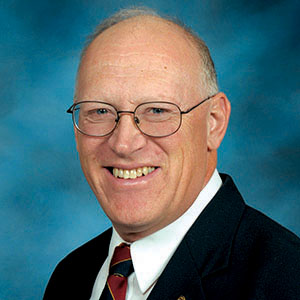Kansas Profile – Now That’s Rural: Gary Moss, water conservation
July 12, 2023
By Ron Wilson, director of the Huck Boyd National Institute for Rural Development at Kansas State University
 National Public Radio is broadcasting a news report about a new water conservation effort, but not from Washington DC or southern California. Part of it came from the cab of a combine in Kansas.
National Public Radio is broadcasting a news report about a new water conservation effort, but not from Washington DC or southern California. Part of it came from the cab of a combine in Kansas.
They were reporting on an innovative water conservation initiative being led by northwest Kansas farmers.
At right: Gary Moss and wife, Teri | Download this photo
Gary Moss is a fourth-generation farmer near Hoxie in Sheridan County, and a member of the advisory board for this water conservation project. Moss produces irrigated corn, soybeans and wheat and has a cow-calf herd.
Through the years, Moss has seen the significance of the Ogallala Aquifer, the huge underground water reservoir that underlies the western High Plains. He’s also seen groundwater levels fall.
In 1972, the State of Kansas created a state-level position of Chief Engineer and provided for groundwater management districts across the state. Over the decades, groundwater districts in some regions were seeing depletion of underground water.
Moss and other producers saw a need to get together in their part of northwest Kansas. “In 2008, we started holding meetings because the groundwater table was dropping pretty significantly,” he said. The group worked on ways to use water more efficiently, such as re-nozzling sprinklers.
Under Governor Sam Brownback, the Kansas Department of Agriculture conducted a review of state water policy and recommended changes that were adopted by the Kansas Legislature in 2012. Among other things, the legislation allowed a producer to carry over water credits if water use was reduced.
This provided incentive to conserve, rather than the “use it or lose it” policy of the past. The legislation also authorized groundwater management districts to create what was called a Local Enhanced Management Area.
A LEMA helps groundwater management districts conserve water by setting goals and control measures for a specific locally defined region. “It gave us a tool to more effectively manage water conservation ourselves,” Moss said.
Six high priority areas were identified for water conservation in Sheridan County. Ultimately, a LEMA – known as Sheridan Six -- was proposed and approved by the Chief Engineer.
The Sheridan Six LEMA included 99 sections of land and 193 agricultural water wells. (The LEMA does not apply to residential water wells.) Moss served as chair of the Sheridan Six LEMA advisory board. It was the first LEMA adopted in the State of Kansas.
“In 2013, we adopted a five year plan to reduce the amount of water pumped by 20% compared to the five year average,” Moss said.
In the first year of the plan, world grain prices rose significantly. “It was tough,” Moss said. “Prices were high and some farmers were saying, `Why do we have to cut back on water and production when prices are up?’” However, Sheridan Six stayed the course.
“By the end, we achieved nearly a 30% reduction in water use,” Moss said. Research showed that producers inside the LEMA fared about as well financially as outside producers nearby.
“We want to do the right thing,” Moss said. “We want to sustain our operations and pass it on to our kids.”
Gary’s sons, Jake and Jaxsen, attended K-State and came back to Sheridan County. Jake has a business in Hoxie and Jaxsen is farming with Gary. Each boy has a son of his own, who would represent the sixth generation on the farm.
“I believe (the water policy) is working,” Moss said.
The group’s innovative and voluntary conservation strategy captured national attention. When the new policy was implemented, reporters from places such as the Wall Street Journal and National Public Radio made their way to Hoxie to cover the story. “One NPR reporter rode with me in the cab of my combine,” Moss said.
That’s exciting to hear in a rural community such as Hoxie, population 1,211 people. Now, that’s rural.
It made national news when farmers in Kansas voluntarily adopted this plan to cutback and conserve their own water use. We commend Gary Moss and others involved with Sheridan Six for making a difference with this long-term strategy.
For water conservation and for Kansas, that is good news.
Audio and text files of Kansas Profiles are available at http://www.kansasprofile.com. For more information about the Huck Boyd Institute, interested persons can visit http://www.huckboydinstitute.org.
***
The mission of the Huck Boyd National Institute for Rural Development is to enhance rural development by helping rural people help themselves. The Kansas Profile radio series and columns are produced with assistance from the K-State Research and Extension Department of Communications News Media Services unit. A photo of Ron Wilson is available at http://www.ksre.ksu.edu/news/sty/RonWilson.htm. Audio and text files of Kansas Profiles are available at http://www.kansasprofile.com. For more information about the Huck Boyd Institute, interested persons can visit http://www.huckboydinstitute.org.


